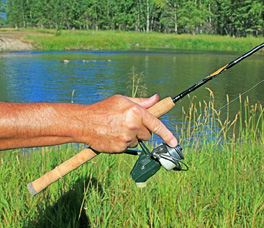Spin Rod

I spin cast differently from nearly everyone else. I open the bail and immediately place my index finger on the lip of the spool. This finger allows an exact release of the line and can be used to feather the flow of line off the reel. It also can break the cast instantly by placing the finger tip back onto the lip. The closer the finger approaches the spool’s lip during the cast, the more it slows down or feathers the cast.
I do this because it helps me cast farther and more accurately than gripping the line inside the curled up index finger. I suggest you learn to cast this way too because it’s an advancement over the traditional way. It also instantly releases the line without the line sliding or jumping along the curled finger. Also, I can increase the drag pressure on a fish by lightly pressing down my forefinger to the revolving spool lip.
My basic cast with an optimally weighted lure begins by bringing the rod progressively fast backwards from two o’clock, then quickly reversing the direction forward to ten o’clock. This backwards cast motion helps load the rod. Most of the progressive speed is in the forward cast. Simply point the index finger by straightening it out at the appropriate time just before the rod stops at ten o’clock. Progressive speed of rod means that it’s a smooth acceleration. When the rod is suddenly stopped, the stored energy in the rod is released to the lure. This action uses primarily wrist motion with some elbow movement to coordinate the cast.
It is vital that your acceleration is smooth and progressive. That means you start out with a slow acceleration and increase it throughout the cast until the sudden stop of the rod. The peak acceleration is at the end of the cast before the stop. The faster you stop the rod, the more kinetic energy will be transmitted to the lure.
Fragile baits are cast with a longer rod arc on the forward cast only. Try to get that rod to load smoothly so when the line is released the bait will not be lost.
There are other useful casts. The pendulum cast is an underhand one which is effective for short, accurate casts which splat down quietly.
There is an effective and efficient way to cast optimally-weighted lures. The distance between the rod tip and lure is about six to eight inches. When fishing lighter lures, I increase this distance to twelve to eighteen inches. For extremely light lures, I omit the back cast and use a forecast with 36-48 inches of line out between rod tip and lure.
When fishing delicate baits which would be flipped off on the back cast, I use the same method as casting the lighter lures.
The purpose again of the back cast is to load the rod with potential energy, then accelerate the forward cast with an already loaded or flexed rod. I find it easy

to cast one hundred feet or more with this method.
The pendulum cast is made by swinging the lure with about four feet or more line out between the rod tip and lure. Swing it back towards you and then swing it towards the target. Again smoothly accelerate the rod speed on the forward swing. Release the line at the right moment.
Accuracy is accomplished by speeding up the rod in the direction that you want the lure to go. It’s the speed up just before the sudden stop that determines the direction the lure will be cast. Feathering the line flow can slow the flight of the lure. I like to purposefully cast too long and feather the line to make the lure drop on the target. This feathering also slows down the lure and aids in making a soft delivery.
Practice casting to targets on your lawn. With practice you can become an accurate caster. The ability to present the lure to the right spot the first time catches the most fish.

© 2025 The Gale Group, Inc. All rights reserved.
© 2025 Perigee Learning LLC. All rights reserved.
LoveTheOutdoors.com is owned and operated by Advameg, Inc. © 2025 Advameg, Inc.
Camping Adventures • Dutch Oven Cooking • Sports Knots
Fly Tying • Freshwater Fishing • Fly Fishing

